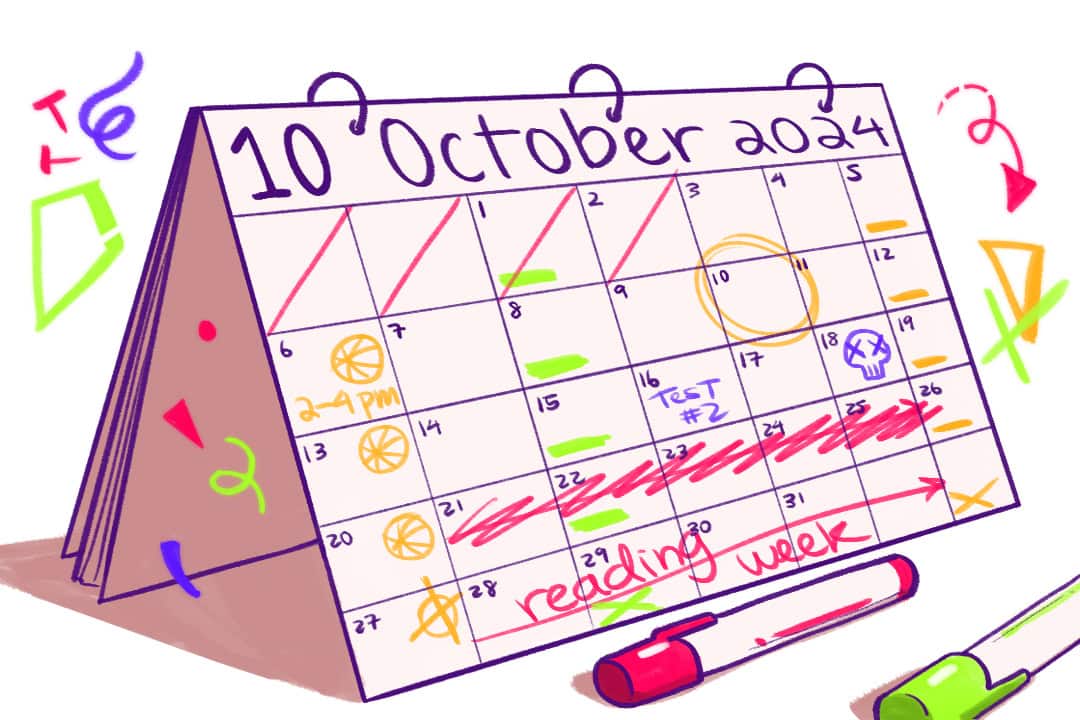For the first time in U of T’s history, the sessional dates for all three campuses have been aligned.
Starting this school year, semester start dates, reading weeks, and exam season dates across all campuses and departments — UTSG, UTM, UTSC, the Faculties of Arts & Science, Applied Science & Engineering, Architecture, Landscape, and Design, Architecture, Music, and Kinesiology & Physical Education — will take place at the same time. Course drop dates remain different across all three campuses.
The alignment is the culmination of years of planning by the Office of the Vice-Provost, Strategic Enrolment Management and yet it presents a drastically new academic environment for students across all campuses. The Varsity decided to look at how the campuses are dealing with the new schedule changes.
What’s new?
The new academic dates have a variety of implications for students across the three campuses.
The biggest shift in the new academic dates is the reading week. Fall reading week will now take place from October 28 to November 1, after the midway point of the semester.
While this new date is only one week earlier than UTSG’s previous reading week, it’s about two weeks later than UTSC’s and UTM’s previous reading weeks.
Outside of the reading week shift, other changes to academic schedules have been minimal. For all campuses, the semester started on September 3 and final exams end on December 21.
Reactions from students and faculty
Some students are not happy with the new academic dates. Ayden Lim — a fourth-year media studies and arts management student at UTSC — spoke to The Varsity about the change.
“Originally, reading week gave [students] time to prepare for midterms, now it’s pushed till after exams, which doesn’t give [students] the opportunity to prepare for exams or distress,” said Lim.
Justin Smith, a fourth-year computer science student at UTM, also expressed concerns about the changes. “I think it will affect students negatively, since now we have a super long eight-week stretch without a break to catch up,” he said. “I already feel overwhelmed in week four, and knowing I’m only halfway to a break doesn’t make it better.”
Other students like Danielle Loranty — a fourth-year psychology specialist at UTSC — feel optimistic about the new reading week dates.
“I think it’s great because I thought it was way too early before: you used to do [one month] of school and you already had a break,” said Loranty.
Loranty stated that she and her friends at UTSG can now hang out because their reading weeks are at the same time.
At UTSG, fourth-year sociology and political science student Emily Mastracci also thought there were some positives to the changes. Although Mastracci expressed her concerns regarding the new midterm dates, she said that the changes allow Halloween to fall on reading week this year, “giving students a little more freedom to celebrate without the pressure of tests and assignments.”
Professors have also had to adapt to the change in academic dates this year. Rachel Lobo, an assistant professor in UTSC’s Department of Arts, Culture and Media, had to take a different approach to course planning than she usually does over the summer.
“I didn’t get an announcement about [the sessional date change],” said Lobo, noting that she was only informed about the change by looking at the dates on the registrar’s website.
“Reading week last year was at a nice mid-point in the semester so it gave students a break to do some assignments and catch up on readings. Now that it’s later on in the semester, my midterms are still at the midway point, but students don’t have a study break before the midterm.”
Another change that posed a challenge for Lobo was the reading week change, which caused the shift of UTSC’s drop course deadline from November 20 to 18. Now, Lobo can’t schedule assignments after the reading week break in time for students to get them back before the drop date.
“You only have a two-week turnaround after reading week. By the time you get those assignments back to students, they don’t have a lot of time to decide whether they are going to drop the course or not.”
Students haven’t approached Lobo about the issue yet, but she expects it to become a pressing concern as they get closer to midterm season.
So why the change?
On the U of T Alignment of Sessional Dates for First-Entry Divisions FAQ, the university notes that the reason behind the change included confusion with the “start and end of classes across divisions, the lack of fall break for students and faculty registered/teaching courses across divisions, and inequalities resulting from different payment deadlines and some students writing final exams, while attending courses in other divisions.”
“The decision to align sessional dates for first-entry programs is to address [these] challenges,” wrote the university on the FAQ.
The FAQ also mentions the removal of the 75 per cent refund date, which is to align program fees and refund dates across the three campuses, and the addition of “flex days” — days that can be scheduled as study dates, make-up classes, or meet the number of contact hours.
When registrars committed to aligning the seasonal dates across campuses in October 2022, the UTSC Registrar and Assistant Dean Strategic Enrolment Management Shelby Verboven noted during the October 20, 2022, UTSC Academics Affairs Committee that the different dates across the three campuses caused “confusion and stress” and that each campus would have to “make some concessions,” as a result of the changes.



No comments to display.